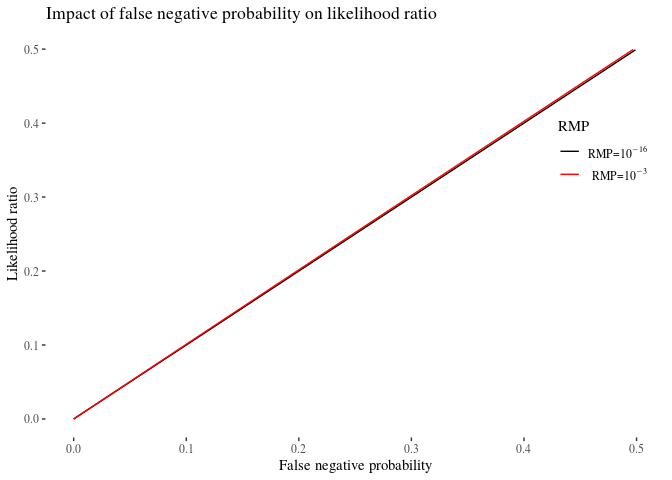Probably?
(Mainly) bayesian data analysis with a philosophical twist
False positives
False positives
In a few recent posts we discussed the error probability for false positives in DNA evidence evaluation. Now, let’s think about the error probability for false negatives and its impact on the value of exculpatory DNA evidence. Consider the probability of no match being reported if an error has been made, analogous to k above: Now, the likelihood ratio calculations, assuming l = 1, go as follows:
If the error rate is 0, then the numerator is 0 and so is the , as it should. In such a case, the evidence is completely exculpatory, the posterior probability that the suspect is the source will be also 0. If the error rate is not 0, the numerator simply is the probability of error, and the numerator takes values between 1 − RMP and 1, depending on the value of e. Quite crucially, 1 in the denominator is decreased by (1−e)RMP, which with usually very low RMP in the case of DNA evidence is a very small change as compared to one, so the denominator stays very close to 1 even if e is very high, and the effectively simply is $\approx \nicefrac{e}{1} = e$. The lines in Figure , strictly speaking, do not overlap, but the difference between them (with RMP being fairly low) is negligible.
rmp9 <- 10e-16
rmp3 <- 10e-3
fnp <- seq(0,0.5, by = 0.001)
lr9n <- fnp/(1 + ((fnp -1) * rmp9))
lr3n <- fnp/(1 + ((fnp -1) * rmp3))
fnpTable <- data.frame(fnp, lr9n, lr3n)
library(tidyr)
fnpTableLong <- gather(fnpTable,line,value,c(lr9n,lr3n), factor_key=TRUE)
ggplot(fnpTableLong, aes(x=fnp,y=value, color = line))+ geom_line()+theme_tufte()+ylab("Likelihood ratio")+xlab("False negative probability") +scale_color_manual(values = c(1,2),labels =
c(expression(paste("RMP=",10^{-16})),expression(paste("RMP=",10^{-3}))))+ggtitle("Impact of false negative probability on likelihood ratio")+ theme(legend.position = c(0.9,.7))+ylim(c(0,0.5))+ labs(color = "RMP")

Interestingly, the situation is not symmetric when we compare FPP to FNP. Recall from the previous posts that with FPP, the likelihood ratio is 50 when e = 0.01 for RMP = 10−3, while for the same e and RMP it is 0.01 for FNP, an hundredfold decrease. This illustrates that the exculpatory value of DNA evidence is higher than its incriminating value, even if the error rates and random match probabilities are the same.
x <- seq(0, 1, by = 0.01)
dfn <- rep(1, length(x) )
dfp <- -1/(x^2)
ggplot()+geom_line(aes(x=x,y=dfp, color = "incriminating"))+geom_line(aes(x=x,y=dfn, color = "exculpatory"))+ylim(c(-10,2))+theme_tufte()+
theme(legend.position = c(0.8, 0.2), legend.title = element_blank())+ylab("likelihood ratio")+xlab("error rate")
